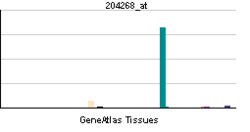S100A2
S100 calcium-binding protein A2 (S100A2) is a protein that in humans is encoded by the S100A2 gene.[2]
The protein encoded by this gene is a member of the S100 family of proteins containing 2 EF-hand calcium-binding motifs. S100 proteins are localized in the cytoplasm and/or nucleus of a wide range of cells, and involved in the regulation of a number of cellular processes such as cell cycle progression and differentiation. S100 genes include at least 13 members which are located as a cluster on chromosome 1q21. This protein may have a tumor suppressor function. Chromosomal rearrangements and altered expression of this gene have been implicated in breast cancer.[3]
References
Further reading
- Schäfer BW, Heizmann CW (1996). "The S100 family of EF-hand calcium-binding proteins: functions and pathology". Trends Biochem. Sci. 21 (4): 134–40. doi:10.1016/S0968-0004(96)80167-8. PMID 8701470.
- Rasmussen HH, van Damme J, Puype M, et al. (1993). "Microsequences of 145 proteins recorded in the two-dimensional gel protein database of normal human epidermal keratinocytes". Electrophoresis. 13 (12): 960–9. doi:10.1002/elps.11501301199. PMID 1286667.
- Lee SW, Tomasetto C, Swisshelm K, et al. (1992). "Down-regulation of a member of the S100 gene family in mammary carcinoma cells and reexpression by azadeoxycytidine treatment". Proc. Natl. Acad. Sci. U.S.A. 89 (6): 2504–8. doi:10.1073/pnas.89.6.2504. PMC 48687
 . PMID 1372446.
. PMID 1372446.
- Schäfer BW, Wicki R, Engelkamp D, et al. (1995). "Isolation of a YAC clone covering a cluster of nine S100 genes on human chromosome 1q21: rationale for a new nomenclature of the S100 calcium-binding protein family". Genomics. 25 (3): 638–43. doi:10.1016/0888-7543(95)80005-7. PMID 7759097.
- Gimona M, Lando Z, Dolginov Y, et al. (1997). "Ca2+-dependent interaction of S100A2 with muscle and nonmuscle tropomyosins". J. Cell. Sci. 110 (5): 611–21. PMID 9092943.
- Böni R, Burg G, Doguoglu A, et al. (1997). "Immunohistochemical localization of the Ca2+ binding S100 proteins in normal human skin and melanocytic lesions". Br. J. Dermatol. 137 (1): 39–43. doi:10.1111/j.1365-2133.1997.tb03698.x. PMID 9274623.
- Groves P, Finn BE, Kuźnicki J, Forsén S (1998). "A model for target protein binding to calcium-activated S100 dimers". FEBS Lett. 421 (3): 175–9. doi:10.1016/S0014-5793(97)01535-4. PMID 9468301.
- Wicki R, Franz C, Scholl FA, et al. (1998). "Repression of the candidate tumor suppressor gene S100A2 in breast cancer is mediated by site-specific hypermethylation". Cell Calcium. 22 (4): 243–54. doi:10.1016/S0143-4160(97)90063-4. PMID 9481475.
- Franz C, Durussel I, Cox JA, et al. (1998). "Binding of Ca2+ and Zn2+ to human nuclear S100A2 and mutant proteins". J. Biol. Chem. 273 (30): 18826–34. doi:10.1074/jbc.273.30.18826. PMID 9668057.
- Mueller A, Bächi T, Höchli M, et al. (1999). "Subcellular distribution of S100 proteins in tumor cells and their relocation in response to calcium activation". Histochem. Cell Biol. 111 (6): 453–9. doi:10.1007/s004180050381. PMID 10429967.
- Stradal TB, Troxler H, Heizmann CW, Gimona M (2000). "Mapping the zinc ligands of S100A2 by site-directed mutagenesis". J. Biol. Chem. 275 (18): 13219–27. doi:10.1074/jbc.275.18.13219. PMID 10788426.
- Hoyaux D, Decaestecker C, Heizmann CW, et al. (2000). "S100 proteins in Corpora amylacea from normal human brain". Brain Res. 867 (1–2): 280–8. doi:10.1016/S0006-8993(00)02393-3. PMID 10837826.
- Deshpande R, Woods TL, Fu J, et al. (2000). "Biochemical characterization of S100A2 in human keratinocytes: subcellular localization, dimerization, and oxidative cross-linking". J. Invest. Dermatol. 115 (3): 477–85. doi:10.1046/j.1523-1747.2000.00078.x. PMID 10951287.
- Nagy N, Hoyaux D, Gielen I, et al. (2002). "The Ca2+-binding S100A2 protein is differentially expressed in epithelial tissue of glandular or squamous origin". Histol. Histopathol. 17 (1): 123–30. PMID 11813862.
- Kyriazanos ID, Tachibana M, Dhar DK, et al. (2002). "Expression and prognostic significance of S100A2 protein in squamous cell carcinoma of the esophagus". Oncol. Rep. 9 (3): 503–10. doi:10.3892/or.9.3.503. PMID 11956617.
- Zhang T, Woods TL, Elder JT (2003). "Differential responses of S100A2 to oxidative stress and increased intracellular calcium in normal, immortalized, and malignant human keratinocytes". J. Invest. Dermatol. 119 (5): 1196–201. doi:10.1046/j.1523-1747.2002.19520.x. PMID 12445212.
- Strausberg RL, Feingold EA, Grouse LH, et al. (2003). "Generation and initial analysis of more than 15,000 full-length human and mouse cDNA sequences". Proc. Natl. Acad. Sci. U.S.A. 99 (26): 16899–903. doi:10.1073/pnas.242603899. PMC 139241
 . PMID 12477932.
. PMID 12477932.
- Hibi K, Fujitake S, Takase T, et al. (2004). "Identification of S100A2 as a target of the DeltaNp63 oncogenic pathway". Clin. Cancer Res. 9 (11): 4282–5. PMID 14519656.


 . PMID 8341667.
. PMID 8341667. . PMID 1372446.
. PMID 1372446. . PMID 12477932.
. PMID 12477932.